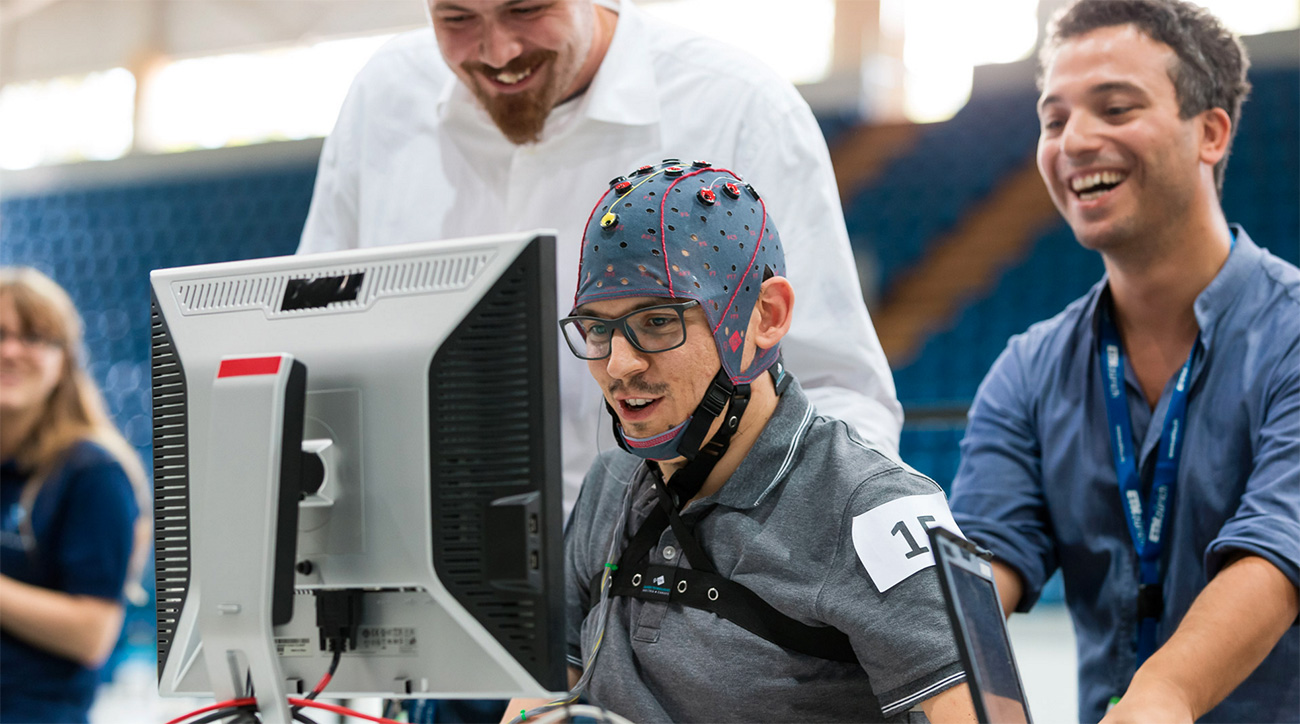Assistive technology shines at Cybathlon in Zurich
Read about the latest sports tech news, innovations, ideas and products that impact players, fans and the sports industry at SportTechie.com.
ZURICH — It was a virtual running race with obstacles. But it was no ordinary computer game.
Competitors controlled their race avatars on the screen using only their thoughts and no other body movement. Their thoughts were translated into virtual action through a cap with multiple electrodes fitted on their head. Much like athletes in shooting or archery, contestants needed a sharp focus. But the fact that they were quadriplegic set this race apart. People with severe motor disabilities had just successfully used a computer device through their brain signals.
Like in any other race, the winners were greeted with loud cheers from the audience. In this case, it was a home team, Brain Tweakers from Switzerland. This was the Brain Computer Interface (BCI) race, one of the six disciplines, at the world’s first Cybathlon that concluded Saturday.
BCI technology is not a novel concept, but Cybathlon provided it a platform to test the current research. Other than BCI, the disciplines included obstacles races with prostheses, wearable exoskeletons, powered wheelchairs and functional electrical stimulation bikes. The one-day event pitted existing as well as prototype assistive technologies for people with disabilities. It presented the use of these modern devices as an audience spectacle.
The Powered Leg Prosthesis Race was the fastest paced of all the disciplines. Helgi Sveinsson and his team, Össur Rheo Knee, finished the six tasks in 63 seconds. The prosthetic leg the Icelandic pilot, Paralympian and current European javelin champion used is currently available on the market. In the Powered Arm Prosthesis Race, competitors completed everyday tasks such as slicing bread, pinning clothes on a line and lifting objects with their prosthetic arms. Each action required a different grip.
Pilots with complete paralysis competed in the Functional Electrical Simulation (FES) bike race. Their pedal movements were artificially stimulated through electrodes. This technology allows paralyzed muscles to move. All the bikes were non-motorized. The technology powered their movements but the pilots still had to channel their power and stamina to win the 750-meter indoor race. So even though the participants didn’t feel any sensations in their paralyzed muscles, they had to train for the race.
Subscribe to the
SportTechie Newsletter
- NFL media roundtable: Storylines to watch
- Why Mark Cuban won't invest in e-sports teams
- New hockey technology impresses at World Cup
The Powered Exoskeleton Race looked daunting. The pilots were not able to finish most tasks in the race, including the final winner. It would be a dream come true for any paraplegic to have the mobility to walk freely again, and that is precisely what these powered exoskeletons were aiming for. However, this race was an example that proved that there is a massive scope for the development of wearable exoskeletons. Similarly, in the Powered Wheelchair Race, the existing assistive technology did not seem to cope well with climbing up and down a flight of stairs, as most finalists spent the longest completing this task.
Through all these disciplines, the Cybathlon managed to bring out the best of some assistive technologies and challenged some others. Unlike the Paralympics, which celebrates athletic performance and strives for equality, Cybathlon aimed to create a competition where technology developers worked with people with disabilities to help them to solve their daily obstacles. In doing so, it also gave the public a few evocative moments.
While it does not look likely that assistive technology will be used in mainstream sporting events like Olympics or Paralympics in the near future, developments in assistive technology can lead to better injury management and quicker recovery. For example, exoskeletons are currently used for physiotherapy. Better assistive technology promises a possibility of training with a lower risk of injury for athletes.
Cybathlon lived up to its primary motive and brought the general public, technology experts and disabled community on the same stage. It was a peek in to how far assistive technology has come and how far it still needs to go.






